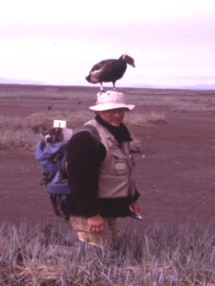Introducing a new bird to the flock: UM Professor Dr. Thomas Riecke

Earlier this year, the University of Montana welcomed Dr. Thomas Riecke as the James K. Ringelman Chair of Waterfowl Conservation, to the faculty of the Department of Ecosystem and Conservation Science. Dr. Riecke specializes in quantitative modeling of bird populations; among many other things, he studies how environmental conditions and animal behavior affect reproductive success and rates of population change in waterfowl. Before moving to Montana, Dr. Riecke was a postdoctoral fellow at the Swiss Ornithological Institute, where he focused on life history trade-offs in White-throated Dippers nesting along frigid mountain streams. That work followed PhD and postdoctoral research on Brant (geese), which nest on the western coast of Alaska. But Dr. Riecke hasn’t always worked in these chilly northern-hemisphere systems.

White-throated Dipper. Photo courtesy of Thomas Riecke.
Dr. Riecke’s interest in birds began while growing up in Dallas, where the metropolitan area alone has over 300 species of birds. Across Texas, species counts may number twice that many. So as a child, Dr. Riecke was well positioned to become a keen backyard-birder. As a master’s student in Nacogdoches, he focused on the effects of lead exposure on the nesting ecology of Black-necked Stilts (spoiler alert, they’re not good). While he was collecting data and observing nesting behavior in the field, he noticed that during highwater events, some stilts were inexplicably abandoning their nests—even though they nested above the flood line. Dr. Riecke looked closer and noticed that introduced fire ants, which had colonies in the flood zone, were swarming uphill to the area where the Black-necked Stilts were nesting. He found a nesting Stilt covered in fire ants. Although he suspects nest abandonment due to introduced fire ants may be a relatively minor problem compared to other threats (predators, for example), he noted that this may be one more effect of an exotic invasive not often considered.
After completing his Master’s degree, Dr. Riecke left the subtropical climes of eastern Texas to start PhD research on the Yukon-Kuskokwim River Delta in Western Alaska, where he worked with a population of Brant that had been observed for decades by his advisor at the University of Nevada, Reno, Dr. James Sedinger. Dr. Sedinger started collecting data on this Brant breeding colony in 1984; he and his colleagues have continued observations through the present. The project just celebrated its 40th field season. Unfortunately, over that course of time, the researchers have watched the Brant population decline, largely due to changing habitat conditions.

Dr. James Sedinger, in the field with a Brant. Photo courtesy of Thomas Riecke.
Dr. Riecke and his collaborators examined these changes in population size and determined that the data pointed to environmental conditions as potential drivers of population changes. Brant, small-bodied geese, display a number of characteristics that make them particularly vulnerable to unstable environmental conditions. First, they have a slow-paced life history strategy; nesting for the first time at 2-3 years old, producing relatively small clutches of 3-5 eggs, and caring for their young. Second, they have a high degree of natal philopatry, meaning that most individuals return to the same breeding grounds every year—this after migrating to winter ranges as far away as Mexico. And third, they are dietary specialists; in the non-breeding season, Brant specialize on common eelgrass. But once they return to their breeding habitat, they shift to feeding on Hoppner’s sedge, which at some of the Brant’s major breeding areas is also in decline. These traits don’t bode well for the species in the face of the many contemporary threats they face from climate change, urbanization and agricultural expansion.
At UM, Dr. Riecke will continue to collaborate on work with the Brant population in the Yukon delta, and is now also applying techniques used in his work in Texas, Alaska and the Swiss Alps, to systems here in Montana, where he and his students have started a research project on Lesser Scaup in the Centennial Valley. More generally, Dr. Riecke will serve as an invaluable resource for Montana’s wildlife ecology community.

The Swiss Alps. Photo courtesy of Thomas Riecke.
To learn more about Dr. Thomas Riecke’s research program, check out some of his publications listed below, or visit his webpage.
- Riecke, Thomas V., Johann Hegelbach, and Michael Schaub. “Reproductive senescence and mating tactic interact and conflict to drive reproductive success in a passerine.” Journal of Animal Ecology 92.4 (2023): 838-849.
- Riecke, Thomas V., et al. “A hierarchical model for jointly assessing ecological and anthropogenic impacts on animal demography.” Journal of Animal Ecology 91.8 (2022): 1612-1626.
